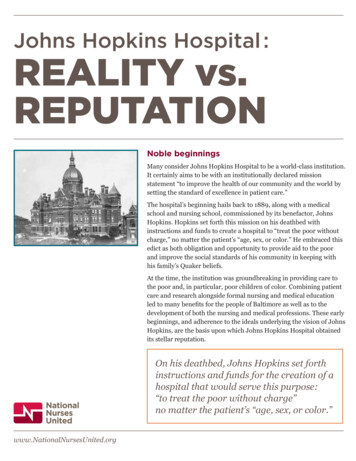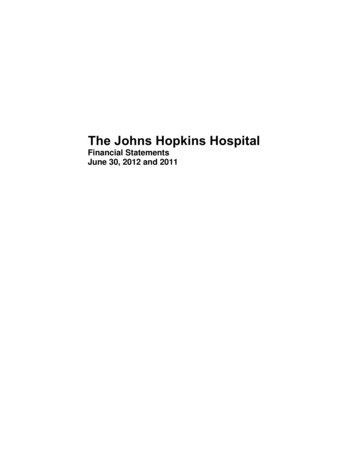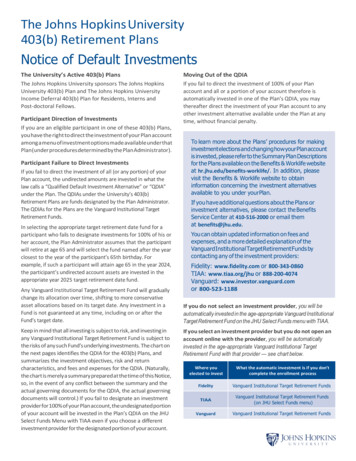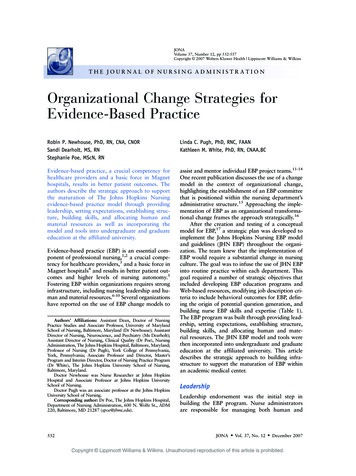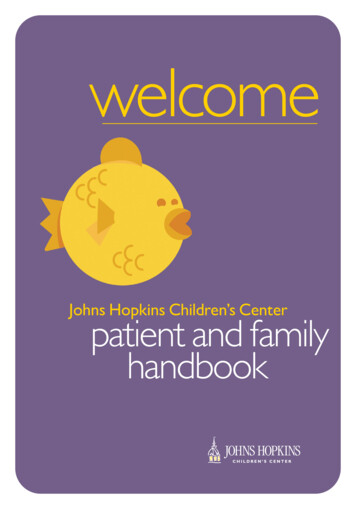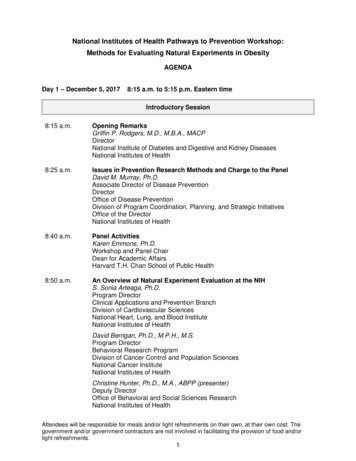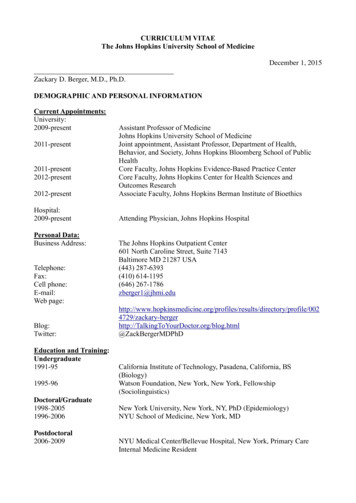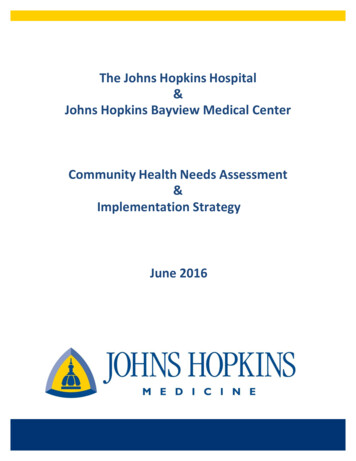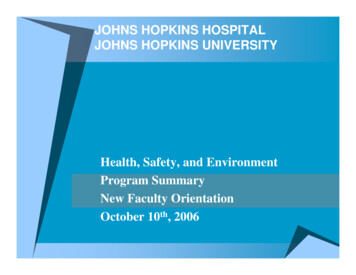
Transcription
JOHNS HOPKINS HOSPITALJOHNS HOPKINS UNIVERSITYHealth, Safety, and EnvironmentProgram SummaryNew Faculty OrientationOctober 10th, 2006
Health, Safety And Environment OrganizationJohns Hopkins InstitutionsJHHSBoard of TrusteesJHUBoard of TrusteesCEOJohns HopkinsMedicinePresidentJHUJHHMedical BoardPresidentJHHSRadiation SafetySafety AdministrationEnvironmental andChemical SafetyJHH SafetyWorkgroupChemicalHygieneCommitteeJoint Committee forHealth, Safety and ommitteeBiosafetyCommitteeOccupational Health Services East Baltimore and HomewoodOccupational Injury ClinicWorkers’ Compensation OfficeProtectiveDevicesCommitteeLaser SafetyCommitteeInstitutionalAnimal Care andUse CommitteeRiskManagementCommittee
Health, Safety and EnvironmentOrganizationExecutive DirectorHealth, Safety and EnvironmentAdministrativeCoordinatorCenter forOccupational andInformationSystemsEnvironmental HealthSafetyAdministrationOccupationalHealth ServicesEast etyEnvironmentalandChemical SafetyOccupationalHealth suscitationProgramFaculty andStaff AssistanceProgram
Occupational Injury Clinic Performs assessment and treatment ofwork related injury and illness. Conducts post-exposure management ofbloodborne pathogens (HIV, HBV,HCV). Conducts early detection/interventionergonomics/early return-to-workprograms (in cooperation with SafetyAdministration). Maintains OSHA 300 Log.
Report of Incident FormThe form and instructions for completing it can be found at:http://www.hopkinsmedicine.org/hse/forms/Report of Incident.pdf
Industrial Hygiene & Ergonomics Identifies and controls chemical, physical andergonomic hazards.Monitors and administers hazardous chemicalwaste disposal program.Conducts environmental sampling monitoring.Responds to chemical spills and accidents.Investigates complaints related to workplaceexposures.Conducts training in the use, control, disposal,and shipping of hazardous chemicals.EPA compliance.
Safety Management Conducts periodic facility surveys and laboratory safety inspections.Performs incident investigations and record keepingfunctions.Conducts job hazard analyses.Responds to fire and other emergency situations.Surveys all Hospital/University areas for compliancewith regulatory standards and public healthpractices.Conducts safety training (Biohazard, HazCom, FireSafety, Bloodborne Pathogens, TB, etc.).
Occupational Health Services Conducts pre-employment health screenings (Hepatitis B,Varicella, Rubella, Rubeola, Drug Screen, HealthAssessment, TB Testing). Performs immunizations (Hepatitis B, Rubella, Rubeola,Tetanus, Rabies, MMR). Conducts Flu Vaccine Program (immunization ofemployees and faculty/staff). Conducts tuberculosis prophylaxis evaluations andtreatment as necessary for PPD converters. Performs return-to-work clearance (any employeemedically absent from work for more than seven daysand any employee who is absent for a communicable orcontagious disease) .
Management of HazardousMaterials/ChemicalsHSE Policy 701:Hazard Communication Also called OSHA’s “Employee Right to Know” law. This is communicated in two ways—Material Safety DataSheets (MSDSs) and labels.States every employee has a right to know every hazardassociated with each chemical they work with.
HSE 701- Hazard CommunicationMSDS’ can now be found on line iron health.htm#MSDSRelated PoliciesHSE 703 – Management of Hazardous ChemicalsCovers transport, storage, use, disposal, and Policies/HSE Policies/indiv sections/hse703.pdf
Response to FIRE/SMOKE1.2.3.4.5.Remove anyone in immediate dangerClose the doorPULL THE ALARM (found along your exitroute)Call 5 – 4444 to give location of fire.Do not use fire extinguishers unless you havebeen formally trained on an annual basis.
How do you respond to a fire alarm inyour area? Healthcare Occupancy: Defend in place. Close doors, clear hallways,and place all patients and visitors in theirrooms. Business Occupancy: Evacuate patients, visitors, and employees toa connecting building.
Training Classes Hazard Communication Bloodborne Pathogen Shipping (DOT/IATA) Supervisor Safety Laboratory Safety
HSE m
Johns Hopkins BiosafetyOverviewThe goal of the Biosafety Office is to: Promote the safe handling of potentialbiological hazards including RecombinantDNA, Infectious Agents and Pathogens(including bloodborne pathogens associatedwith human tissues), and Biological Toxins Ensure Compliance with Federal, State, andJHU regulations and policies.
The Principal Investigator isultimately responsible for: Compliance with all Federal, State andInstitutional Policies The safety and training of all directlyassociated laboratory and administrativestaff
You Are Not Alone We Are Here To HelpBiosafety Office Administration:Stephen C. Dahl, Ph.D., RBP, Biosafety OfficerWeiying Pan, Ph.D., Associate Biosafety OfficerTylicia McRae, Institutional Biosafety Committee CoordinatorKathleen Cook, Administrative AssistantBiological Safety Cabinet Certification Team:Tamie Maier, Service CoordinatorTim Travers, Technical Supervisor, NSF-certified TechnicianEric Flutka, NSF-certified TechnicianBryan Kahler, NSF-certified TechnicianRobert Williams, TechnicianResearch Safety Specialists/Laboratory Inspection TeamJack Barrett, M.S., HEMElise Hopkins, HEM
Biosafety Compliance What Do You Need To Know? Research RegistrationsSelect Agent OversightInstitutional Biosafety CommitteeBiosafety Cabinet CertificationsLaboratory Inspection ProgramLaboratory Safety Training
Research RegistrationsWhat to register? Recombinant DNA/RNAPathogens and Infectious AgentsBiological ToxinsHuman Tissues– Clinical Focus– Laboratory Focus
Registration FormsWhat is needed? Identify vector(s) and insert(s)Identify agent(s)Identify host(s)Identify delivery system(s)Identify personnelIdentify known and potential safety issuesIdentify methods and overall goals
Recombinant DNA Federal Requirement National Institutes of Health Guidelines– http://www4.od.nih.gov/obaThe NIH Guidelines for Research involvingRecombinant DNA Molecules specifies practices forconstructing and handling (i) recombinant DNAmolecules and (ii) organisms and viruses containingrecombinant DNA molecules(Lifted from section I-A of the Guide)
Pathogens andInfectious Agents Johns Hopkins Institutions Policy(Federal Regulation for Select Agents) CDC/NIH BMBL is the accepted standard– Biosafety in Microbiological and iosfty/bmbl4/bmbl4toc.htm)– Assignment of biosafety containment (BSL1 –BSL4) and required procedures and practices
Biological Toxins Johns Hopkins Institutions Policy(Federal Regulation for Select Agents) Select Agent Toxins have possession limits.Investigators at or below the trigger value need onlyregister with the Biosafety Office. Quantities above thethreshold require formal application, inspection, andFBI clearance including fingerprint registration.
Human Tissue OSHA Bloodborne Pathogen Standard All personnel who may come in contact withhuman tissues or body fluids (including thosewho package and ship specimens) must receiveannual bloodborne pathogen training. Yes, human cell lines count Yes, we offer classroom and online courses.
There are Two Types ofHuman Tissue Registrations Clinical Focus– Investigator only needs to register once.– Personnel list must be maintained– Universal precautions Laboratory Focus– Investigator only needs to register once– Personnel list must be maintained– Biosafety Level 2 (BSL2)
Institutional BiosafetyCommittee (IBC) Reviews all research registrations except exempt DNAand Human Tissue Reviews clinical trials involving gene transfer and/orany introduction of pathogens or infectious agents intohuman subjects. Meets monthly. Materials received in a given monthwill be considered the following month.
Important!Your registration is not in effect until it hasbeen approved by the IBC.The use of recombinant DNA, pathogens,infectious agents, or biological toxinswithout IBC approval is in violation ofFederal, State, and/or Johns Hopkinsregulations.
Biological Safety CabinetCertification Annual certification is required by NIH, CDC,and/or JHU policies JHU maintains an in-house Biosafety CabinetCertification Team with NSF-certified techs. Biosafety Cabinets are regulated by theBiosafety Office. You must contact us if youintend to purchase, decommission, or move aBiosafety Cabinet.
Laboratory Inspections Required by Johns Hopkins Policies Laboratories will be inspected annually for:– Proper chemical storage and disposal– Proper biomedical/biohazardous waste disposal– Proper compliance with the BMBL– Proper hazard, materials, and contact signage– Proper maintenance of safety and emergencyequipment such as eyewash and BSC.
Training Opportunities Laboratory SafetyBSL1 and BSL2 Practices and ProceduresBSL3 Practices and ProceduresBiological Safety Cabinet Practices and ProceduresBloodborne Pathogen Training ( /- Monkey Module)DOT/IATA Dangerous Goods Shipping Course*Radiation Safety*Fire Safety and Hazard Communication Training**(These courses are offered through HSE, but not specifically by the Biosafety Office)
Contact the Biosafety Office Phone: 410 – 955 – 5918 FAX410 – 955 – 5929 Email: biosafety@jhu.eduibc@jhu.eduAll of the following URLs work so pick your favorite! www.hopkinsmedicine.org/hse/biosafety.htm www.hopkinsbiosafety.orgwww.jhubiosafety.org www.hopkinsibc.orgwww.jhuibc.org
Radiation Control UnitStan Wadsworth,Radiation Safety Officer2024 E. Monument Streetstanwads@jhmi.edu410-955-3710
Mission: Facilitate the safe and efficacious useof radiation sources in research,medical diagnosis, therapy, andeducation while maintainingcompliance with regulatory licensing,registration, and accreditationstandards.
RadioactiveMaterialsResearch: The use of radioactive materials bypersonnel at Johns Hopkins is authorizedby a radioactive materials license. Applications for use shall be submitted tothe Committee through the RadiationSafety Officer.
HumanResearch: Administration of radiation (x-rays orradioisotopes) to human subjects inresearch projects must be made onRCU form 5 Completed form should be sent to theJHMI Clinical Investigation Committee
Services offeredby the RadiationControl Unit: Radiation safety trainingLaboratory and clinic surveysPersonnel dosimetryReview of applications forradioactive material use Emergency response
Services cont’ Radioactive waste disposalInstrument calibrationRadioactive source lsupport
Services cont’ Review of applications forradioactive material use X-ray shielding analysis X-ray machine surveys Consultative services
Forms, Policies,Worksheets http://www.hopkinsmedicine.org/hse/forms.htm http://www.hopkinsmedicine.org/hse/Policies.htm http://irb.jhmi.edu/forms/
Safety Management Conducts periodic facility surveys and laboratory safety inspections. Performs incident investigations and record keeping functions. Conducts job hazard analyses. Responds to fire and other emergency situations. Surveys all Hospital/University areas for compliance with regulatory standards and public health practices. Conducts safety training (Biohazard, HazCom, Fire
